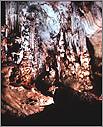PALAEOLITHIC CAVE ART |
Jim Hollander | Select image to enlarge |
Ancient paintings executed on dark cave walls were first glimpsed by a young girl named Maria who looked up and exclaimed, "Look Papa, bulls!" The cave, Altimira, in northern Spain had had no visitors for the past 14,000 years until Maria and her father, sat in the flickering darkness of a lamp and saw the bulls, oxen and bison so vividly prancing on the ceiling of the cave. Scenes that would open a new chapter to artistic expression as well as to science. Since then scores of caverns containing prehistoric cave paintings dating back as far as 30,000 years have been discovered in Spain, France Italy and most recently Portugal, uncovering a treasure chest of thousands of works of art. These have been pored over by scientists and laymen alike who have come up with theories ranging from the simple to the absurd, all trying to explain why ancient Cro Magnon man ventured into the dark and dangerous caves to depict the animals who roamed the icy plains of that time. As well, the symbols that early man used and obviously held so dear. Twenty thousand years ago in Europe, in the lands south of the glacial ice sheet, our ancestors had already evolved a means of expressing their inner life or being. Essentially nomadic, living in a cold, harsh environment, at the mercy of ebbing and flowing glacial periods, they sought out caves as protection from the elements, and in the dark recesses of these caves they painted their own experiences. The times were hard back then. There was a very thick layer of ice covering or slowly receding from much of what is modern day Europe and man's existence depended on strength and cunning to stay alive by killing wild animals with the most rudimentary stone and wood weapons. Archaeologists tell us much about his way of life, his family structure and even his burial practices, but little can be told with certainty about the "why" that made him paint his legends or fears or initiation rites on cave walls. Experts differ widely in their interpretation of the origins of this art. Some say it was the human need and desire for adornment; other's claim it depicted man's anxiety and fear of the universe, the unknown. Possibly it was an urge to communicate thought, or part of magic and ritual, calendar records or perhaps art for art's sake. We will never know, can only speculate. Whatever the reason, cave paintings were a universal, integral part of Stone Age man's existence. The cave man used the tools he found at hand. His pigments were ochre and manganese and iron dug from the earth and mixed with animal fat. Or charcoal, perhaps left from the same fires which burned to light the darkness of his cave. His canvas was the walls, floors and ceilings of his cavern home, often in large seemingly communal chambers, often in the deepest most difficult to access recesses. Occasionally he used stone or flint tools to engrave or carve a bas- relief. He sometimes employed the natural variation in the surface of the walls to achieve a three dimensional effect. His subject? The things he knew best; the animals upon which he depended for food and clothing - his very existence. Those same animals which could mean danger and death. There are bison, deer, mammoth, ibex and wooly rhinoceros. Fish and horses and bear. He painted and he engraved single figures, animals in pairs, whole compositions. He overlapped lines or superimposed new figures over those of an earlier time or age. He painted too, human figures: male, female, anthropomorphic figures more crudely rendered than animals. He sometimes used his own hand as a stencil. Most intriguing of all he painted signs. Non- representational forms, repeated over and over in never-ending variation. These have been variously interpreted as sexual symbols, counting methods, architectural structures, lunar variations or depiction of plant life. His style? A sense of freeness, a flowing, often sensitive line. An ease of composition. A oneness with his work. This early man, working by the light of charcoal fires or crude oil lamps often in the deepest, darkest recesses of his cave, produced an art form which seldom has been equaled to this day. A universal style - for similar drawing and identical themes are found in caves many hundreds of miles apart - symbols which continued, little changed, for 10,000 years. What these wonders of the dark do is captivate. They were painted before the invention of cultivation, when "man" was Modern but still a hunter and gatherer. With a few quick deft strokes this ancient artist could conjure up the essence of a wooly mammoth or an ibex clambering over jagged peaks, a deadly wild auroch complete with a sense of weight, scale and even expression. Cro Magnon man not only survived to paint another day but evolved into a more modern man over the many thousands of intervening years. He also left behind an artistic legacy that influenced modern artists and captivated and left awestruck all who see and experience this art which belongs to all of mankind. |
||
| Gino Hollander . Jim Hollander . Siri Hollander . Scott Hollander . Barbara Hollander | ||
| Home . Biographies . Contact us | ||
|
E-mail artbygino@gmail.com Phone (505)-927-2072 ©2007 Hollander Collection Site by: Intrcomm Technology |
||










